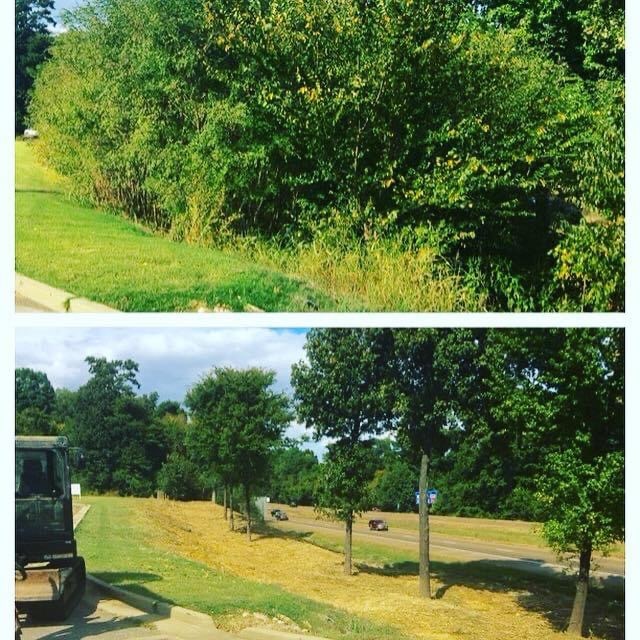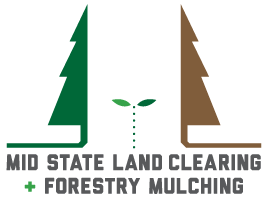Forestry mulching and traditional land clearing are two distinct methods employed in land management, each with its own set of techniques, equipment, and outcomes. Forestry mulching involves the use of specialized machinery, such as a mulching head attached to a skid steer or excavator, to grind down trees, brush, and other vegetation into mulch. This process not only clears the land but also leaves behind a layer of organic material that can enrich the soil and promote new growth.
The method is particularly favored for its ability to handle dense underbrush and small to medium-sized trees efficiently, making it a popular choice for landowners looking to manage overgrown areas or prepare sites for development. In contrast, traditional land clearing methods often involve more aggressive techniques such as bulldozing, chainsawing, and burning. These methods can be effective for large-scale clearing but may lead to significant soil disturbance and environmental degradation.
Traditional clearing often results in the complete removal of vegetation, leaving bare soil that is susceptible to erosion and nutrient loss. The choice between these two methods can significantly impact not only the immediate landscape but also the long-term health of the ecosystem. Understanding the nuances of each approach is essential for landowners, developers, and environmentalists alike.
1. Environmental Impact of Forestry Mulching vs. Traditional Land Clearing
This process reduces the risk of erosion and runoff, preserving the topsoil that is vital for future plant growth. Additionally, the mulch left behind acts as a natural barrier against weeds, suppressing their growth while simultaneously retaining moisture in the soil.
Conversely, traditional land clearing can lead to significant ecological disruption. The use of heavy machinery can compact the soil, making it less permeable and more prone to erosion. Furthermore, when vegetation is removed entirely, the habitat for various species is destroyed, leading to a decline in biodiversity.
The practice of burning cleared vegetation can also release carbon dioxide and other pollutants into the atmosphere, contributing to air quality issues and climate change. In regions where deforestation is a concern, traditional clearing methods can exacerbate these problems by removing trees that play a crucial role in carbon sequestration.
2. Cost and Efficiency Comparison Between Both
When evaluating the cost-effectiveness of forestry mulching vs traditional land clearing, several factors come into play, including labor, equipment, and time efficiency. Forestry mulching tends to be more efficient in terms of time because it combines multiple processes into one operation. The machinery not only clears the land but also processes the vegetation into mulch simultaneously.
This dual function can significantly reduce labor costs and project timelines, making it an attractive option for many landowners. On the other hand, traditional land clearing often requires multiple steps: cutting down trees, removing stumps, and then either hauling away debris or burning it on-site. Each of these steps incurs additional costs related to labor and equipment rental or purchase.
Moreover, traditional methods may necessitate follow-up treatments to manage regrowth or erosion control, further increasing overall expenses. While initial quotes for traditional clearing might appear lower due to competitive pricing in some markets, the hidden costs associated with follow-up work can make forestry mulching a more economical choice in the long run.

3. Advantages & Disadvantages of Each Method
Benefits of forestry mulching that make it an appealing choice for many land management projects. One significant advantage is its environmentally friendly approach; by leaving mulch on-site, it enhances soil health and promotes biodiversity. The mulch layer can also help regulate soil temperature and moisture levels, creating a more hospitable environment for new plant growth.
Forestry mulching is often quicker than traditional methods, allowing landowners to see results sooner. However, forestry mulching does have its limitations. It may not be suitable for all types of vegetation or terrain; for instance, large trees with extensive root systems may require additional processing or different equipment altogether. In short there are several benefits of forestry mulching.
Furthermore, while mulching can suppress weeds initially, it does not eliminate them entirely; ongoing management may still be necessary to maintain a clear site. Traditional land clearing methods also come with their own set of advantages. They are often more effective for large-scale projects where complete removal of vegetation is necessary.
For instance, if a site is being prepared for construction or agriculture where a clean slate is required, traditional clearing may be more appropriate. Additionally, these methods can be more versatile in handling various types of vegetation and terrain.
4. Case Studies and Real-Life Examples
To illustrate the practical applications of forestry mulching versus traditional land clearing methods, several case studies provide valuable insights into their effectiveness in real-world scenarios. In one case study conducted in Florida’s wetlands, a property owner faced challenges with invasive species overtaking native vegetation. The decision was made to employ forestry mulching as a means to clear the area without disturbing the delicate ecosystem.
The mulching process not only removed the invasive species but also left behind organic material that helped restore native plant growth over time. This approach demonstrated how forestry mulching could effectively manage invasive species while promoting ecological balance. In contrast, a large-scale agricultural project in Texas opted for traditional land clearing methods to prepare hundreds of acres for crop production.
Heavy machinery was used to clear vast swathes of land quickly; however, this approach led to significant soil erosion during heavy rains in subsequent seasons. The bare soil was left vulnerable to runoff, which resulted in nutrient loss and sedimentation in nearby waterways. This case highlights how traditional clearing methods can have unintended consequences that may undermine long-term agricultural productivity.
Another example involves a residential development project in Tennessee where both methods were considered. The developers initially leaned towards traditional clearing due to its perceived efficiency in removing large trees quickly. However, after consulting with environmental experts about potential erosion issues and habitat loss for local wildlife, they pivoted towards forestry mulching.
Ready to Clear Your Land? Choose the Right Method Today!
In conclusion, the choice between forestry mulching and traditional land clearing ultimately depends on the specific needs of your project, the environmental considerations at play, and your long-term land management goals. If you find yourself in need of professional land clearing or forestry mulching services in Middle Tennessee, look no further than Mid State Land Clearing LLC. With our extensive experience in the field, we pride ourselves on delivering high-quality results that meet our clients’ expectations. Our team is committed to professionalism and safety, ensuring that every project is executed with care and precision. We understand the importance of getting the job done right the first time, which is why we approach each task with confidence and dedication.
Whether you are looking to clear a small residential lot or manage a larger tract of land, Mid State Land Clearing is here to assist you every step of the way. Our expertise in both forestry mulching and traditional land clearing allows us to tailor our services to fit your specific needs. Contact us today to discuss your project requirements and discover how we can help you achieve your land management goals efficiently and effectively.
